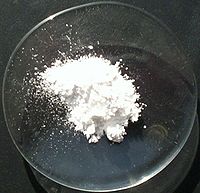
Photo from wikipedia
The current work investigates the effects of filler calcination on the structure and dielectric properties of polyethylene/zirconia (ZrO2) nanocomposites. Calcination temperatures of 600 and 900 °C have been applied to… Click to show full abstract
The current work investigates the effects of filler calcination on the structure and dielectric properties of polyethylene/zirconia (ZrO2) nanocomposites. Calcination temperatures of 600 and 900 °C have been applied to ZrO2 in an attempt to modify its surface chemistry and structure. Calcination results in a slight reduction in the concentration of physically adsorbed water on ZrO2 and, in addition, structural reorganization of the ZrO2 nanopowder. Consequently, the real permittivity of nanocomposites containing calcined ZrO2 is reduced compared to nanocomposites containing uncalcined ZrO2. Furthermore, the DC breakdown strength of nanocomposites containing calcined ZrO2 improves compared to nanocomposites containing uncalcined ZrO2. Since the removed water content is minimal, we primarily attribute the observed dielectric results to structural changes in ZrO2 rather than water-related effects. As such, calcining can have positive effects in enhancing the dielectric properties of ZrO2-based nanocomposites.
Journal Title: IEEE Transactions on Dielectrics and Electrical Insulation
Year Published: 2019
Link to full text (if available)
Share on Social Media: Sign Up to like & get
recommendations!